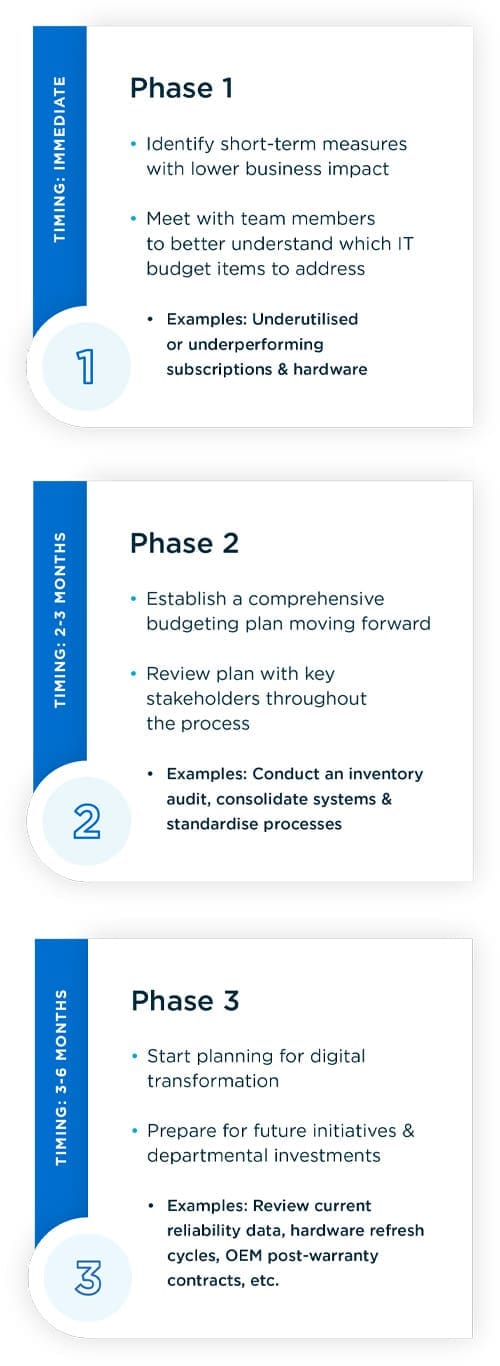Managing the pressure to reduce IT costs in uncertain economic conditions is familiar territory for organisations worldwide. The impacts of the 2008-2009 financial crisis and the COVID-19 pandemic have taught business leaders the importance of clear communication, streamlined processes and optimised spending to maintain resilience. Since economic downturns bring marching orders for IT, finance and other departments to revisit and deploy cost-cutting strategies, it’s vital to start on the right foot.
Establishing a solid partnership with your CFO, CIO and other IT leaders is critical, since this group often leads the charge to reduce business expenses and identify cost-containment opportunities. While IT cost reduction strategies are in motion, ensure everyone has a seat at the table to share goals, address challenges and review solutions together throughout the process.
Identifying how and where to cut costs isn’t always a welcome or straightforward endeavour. However, it presents an opportunity to re-evaluate the status quo and uncover ways to make the most of existing investments. As an IT leader, here’s what you can do now to reduce business expenses, increase efficiency and maximise productivity amid economic headwinds.
Prioritise immediate and long-term IT cost reduction tactics
Whether your cost-cutting initiatives are immediate or downstream, start by aligning current IT investments with high-level business objectives. Doing so highlights which IT resources are essential and will not undergo any cost-cutting measures.
Gartner recommends using a systemic and programmatic approach to long-term cost optimisation and reduction. It’s imperative to resist the urge to cut or freeze resources in one fell swoop. Take the time to assess opportunities and potential obstacles using a multi-phased approach.

Before implementing cost-cutting measures, bring stakeholders up to speed on the next steps and action items. Having open lines of communication provides greater transparency and eliminates working in silos.
Balance capital and operating cost-cutting strategies
Gartner’s recommendations for IT cost reduction encourages leaders to focus on addressing both CapEx and OpEx. Curbing only CapEx initiatives and new projects may seem like the default solution, but it’s not the suggested route to reducing business expenses.
Taking a balanced approach to CapEx and OpEx reductions keeps projects moving forwards without tipping the scale. Addressing both areas results in a balanced and sustainable cost reduction strategy.
Capital expenditure (CapEx)
Once-only costs to maintain or grow the business for more than one year. Examples include IT infrastructure, equipment upgrades, additional data centre space, etc.
Operating expenditure (OpEx)
Reoccurring costs to run the business. Examples include software subscriptions, equipment leases, colocation space, outsourced and managed services, etc.
5 Questions to Ask for IT Budget Planning
CapEx
Maximise current investments to reduce business expenses
Is a costly hardware refresh at the top of the list when considering current and future IT projects? Since it’s your responsibility to reduce business expenses, you’re left with the decision on whether to delay or move forward with a refresh. So, what’s the right path to take?
Your decisions should include the understanding that a hardware refresh isn’t always necessary to meet business and IT demands. If current equipment is meeting business needs and doesn’t require specific upgrades or functionality, extending equipment lifecycles is the way to go. Delaying hardware refreshes by just one year (or more) maximises the existing investment and significantly reduces CapEx.
Take Charge of Your Hardware Refresh Plan
There’s a widespread assumption that as equipment ages, it begins to fail more often – the facts tell another story. Based on over 20 years of hardware refresh and reliability data, our findings show that critical and non-critical server, storage and network equipment remains highly reliable for ten years or more.

When equipment approaches the three-to-six-year mark, OEMs send end of life (EOL) and end of service life (EOSL) notifications. In most cases, when hardware reaches these milestones, it comes with a steep price tag for OEM post-warranty support. If this is the case for your data centre hardware, there’s an opportunity to extend the life of your equipment and benefit from lower support costs with third-party maintenance.
What is EOL & EOSL
OpEx
Temporarily bridge the tech talent gap with managed services
How can IT leaders ask their teams to do more with less while pursuing cost-reduction strategies and ensuring that critical operations remain intact? A fully staffed, robust IT team can take on many responsibilities, but IT leaders are finding it increasingly difficult to maintain such a workforce with widespread talent shortages. Lack of time, budget, resources and capacity limit IT leaders’ abilities to meet changing demands. Significant skill gaps also pose a problem as older generations retire, taking long-held expertise and niche competencies.
According to McKinsey, outsourcing IT responsibilities isn’t a blanket solution for an effective IT talent strategy. Investing in your IT workforce is essential to building and maintaining a talented team well-equipped to provide critical business understanding, productivity and agility.
The good news is that there are options for teams experiencing talent shortages or a lack of resources. Managed services offer IT departments a customisable solution to alleviate stress, stabilise costs and fill talent gaps. By leveraging managed service solutions, IT leaders are better equipped to handle workloads, balance priorities and develop critical IT talent.
IT leaders always prioritise cutting IT costs, but it’s more prevalent when faced with economic slowdowns. The good news is that lowering costs and maintaining business growth is possible. An effective IT cost reduction strategy begins with stakeholder participation and a clear understanding of the high-level priorities. It may feel like everything is resting on your shoulders, but now is the time to find opportunities to drive value, exceed expectations and achieve company initiatives.
Topics:



